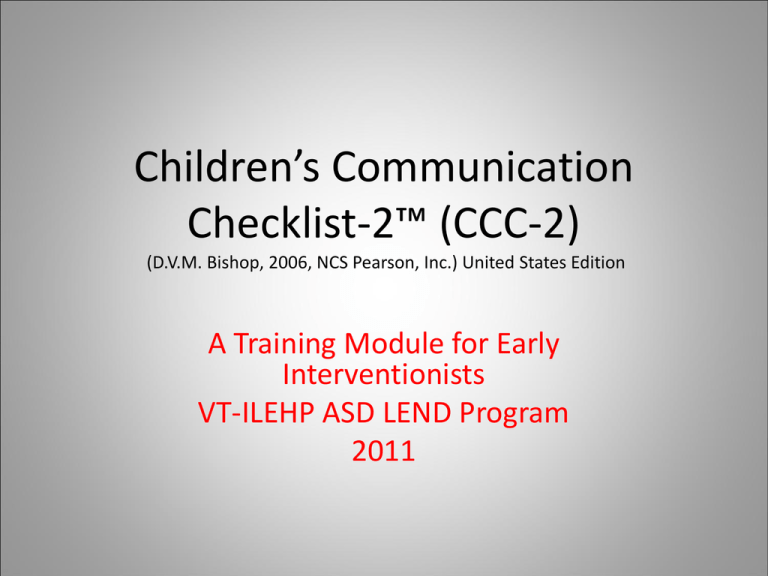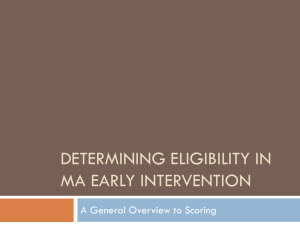CCC-2 Training: Pragmatic Language & ASD Assessment
advertisement

Children’s Communication Checklist-2™ (CCC-2) (D.V.M. Bishop, 2006, NCS Pearson, Inc.) United States Edition A Training Module for Early Interventionists VT-ILEHP ASD LEND Program 2011 Overview of CCC-2™ Purpose Identifies children with pragmatic language impairment Identifies children with possible speech and language impairment Assists in identification of those requiring further assessment of an autistic spectrum disorder (ASD) Overview of CCC-2™ Materials Manual Caregiver Response Form Scoring CD Scoring Worksheet Overview of CCC-2™ Used with children 4:0 to 16:11 who: – Speak in sentences – Primary language is English – Do not have a permanent hearing loss Uses a Caregiver Response Form – An adult who has regular contact with the child – Completion time: 10-15 minutes – Scored by a trained clinician: 5 -15 minutes Overview of CCC-2™ • 70 items divided into 10 scales • Each scale has 7 items (5 address difficulties, 2 focus on strengths) • Scales A, B, C, & D assess articulation and phonology, language structure, vocabulary and discourse • Scales E, F, G & H address pragmatic aspects of communication • Scales I & J assess behaviors commonly impaired in children with ASD Overview of CCC-2™ • • • • • • • • • • Scale A Scale B Scale C Scale D Scale E Scale F Scale G Scale H Scale I Scale J speech syntax semantics coherence initiation scripted language context nonverbal communication social relations interests Overview of CCC-2™ Manual Provides detailed instruction administering scoring interpreting background evidence of reliability & validity Administering and Scoring Caregiver Response Form • Identifies areas of concern • Guides assessment process Respondent should: • Be in regular contact with the child (3-4 days/wk for at least 3 months) • Have appropriate language & literacy skills • Understand the critical nature of his/her responses Administering and Scoring Caregiver Response Form • Items 1-50 = statements that refer to difficulties that effect child’s ability to communicate • Items 51-70 = statements that refer to communication strengths demonstrated by the child Administering and Scoring Rating Key for Caregiver Response Form • 0 = less than once a week (or never) • 1 = at least once a week, but not everyday (or occasionally) • 2 = once or twice a day (or frequently) • 3 = several times (more than twice) a day (or always) 3 = poorest rating for items 1-50 0 = poorest rating for items 51-70 Administering and Scoring Caregiver Response Form – After Completion: • Review for missing responses • Discuss any blank items to encourage completion • Clarify unanswered questions • May use as a guided interview • If only one or two unanswered items remain assign the poorest rating for that section Administering and Scoring Scoring - Two options • Scoring CD • Scoring Worksheet Administering and Scoring Using the Scoring CD • Uses Excel • Has three tabs Instructions Raw Data Summary Administering and Scoring Using the Scoring CD • To derive child’s scores: Complete identifying information Record item ratings Converts raw scores to scaled scores, composite scores and percentile ranks Print and save the summary chart Administering and Scoring Using the Scoring Worksheet Step 1 Complete Identifying Information Step 2 Record Raw Scores (transfer from Caregiver Response Form to Scoring Worksheet) Step 3 Sum Ratings for Section 1 (items 1-50) Step 4 Sum Ratings for Section 2 (items 51-70) Step 5 Check for Consistency Administering and Scoring Using the Scoring Worksheet Step 6 Sum Total Raw Scores Step 7 Derive Scaled Scores Step 8 Derive Percentile Ranks for Corresponding Scaled Scores Step 9 Derive the General Communication Composite (GCC) Standard Score, Confidence Interval, and Percentile Rank Step 10 Derive the Social Interaction Difference Index (SIDI) Score Interpreting CCC-2 Interpretation • Useful in both clinical and research contexts • Combined with other data to aid in clinical decision making • Adds to assessment and intervention processes by describing current behaviors and identifying areas of communication that need additional assessment Interpreting CCC-2 Description of Scores upon which to base your interpretation • Scaled scores • A composite score • An index score • Percentile ranks Interpreting CCC-2 Scaled Scores • Norm-referenced (sample: 4:0 to 16:11) • Derived from raw scores (M = 10, SD = 3) • Domains measured: speech, syntax, semantics, coherence, initiation, scripted language, context, nonverbal communication, social relations and interests. Interpreting CCC-2 General Communication Composite (GCC) • Norm-referenced standard score • Enables comparison of child’s performance to other children the same age • Sum of subtest scaled scores derived from subtests A – H • Represents equal weighting of each subtest • May identify significant communication problems Interpreting CCC-2 Social Interaction Difference Index (SIDI) • Helpful to identify children w/communicative profile characteristic of language impairment or ASD • Typical scores range -10 to 10 (90% of normative sample) • Scores >11 = similar to children w/SLI Dx • Scores <-11= similar to children w/ASD Dx • Use with caution & in combination w/other measures Interpreting CCC-2 Percentile Ranks • Indicate child’s standing relative to others of the same age • Based on standardized sample • Range from < 0.1 to > 99.9 (M = 50) • Provides age-based %ile ranks for scaled scores A through J and the GCC Interpretation Guidelines for Clinical Profiles Children w/Dx of Specific Language Impairment • Expected difficulty with Scales A,B,C, & D • Relatively better with Scales E, H, I and J though generally lower than typically developing communication skills • More likely to have GCC below mean of 100 • More likely to have SIDI that is 11 or greater Interpretation Guidelines for Clinical Profiles Children w/Dx of Pragmatic Lang. Impairment • Often exhibit level pattern of moderate impairment across CCC-2 scales • Typically better on Scales A-D than children w/SLI Dx • On pragmatics scales perform similar to children w/SLI Dx • Identification of pragmatic deficits may be influenced by child’s structural (e.g., syntax) language skills Interpretation Guidelines for Clinical Profiles Children w/Dx of ASD • Profile contrasts w/children with Dx/SLI • Performance on Scales A-D (language skills) below typical levels • Performance on Scales E-J (pragmatic skills) even more depressed • Profiles show low scaled scores on I (social relationships) and J (interests) • Coupled w/SIDI score <-11 suggests possible ASD – refer for further evaluation Interpretation Guidelines for Clinical Profiles Interpretation when not all items are rated • Not possible to derive GCC or SIDI score if three or more items are not rated If no response is obtained, use ratings only as clinical information Do not attempt to summarize the scores Research & Development of CCC-2 • Preceded by CLIC (Checklist for Language Impaired Children) & CLIC-2 • CCC Originally developed for classification of children with known SLI • Interest in wider application as screening tool for SLI led to revision resulting in CCC-2 • Rating scale revised, items added to address semantics and syntax, item order changed & development of additional composite scores Research & Development of CCC-2 • Originally developed in United Kingdom • U.S. Edition has norm-referenced scores using standardized sample representative of children in the U.S. (2005) • n= 950 children in the United States, ages 4:0 – 16:11 • Adaptations for spelling and common wording/phrasing Evidence of Reliability & Validity Evidence of Test-Retest Reliability • n=98 drawn from standardization study • 3 age groups of 30-34 children in each group: 4:0-6:11, 7:0-9:11 and 10:0-16:11 • 52 males and 46 females, representative range of racial/ethnic groups • Caregiver responders representative range of educational levels • Second completion within 1 to 28 days Evidence of Reliability & Validity Evidence of Test-Retest Reliability • r 1,2 range of .86 to .96 reliability coefficients • Reflects strong stability from first to second rating • Reliabilities range from .47-.85 for all scales by ages, from .65-.79 for all scales averaged across all ages. • Reliabilities for GCC range from .94 to .96 indicating very strong reliability Evidence of Reliability & Validity Validity • CCC-2 developed to reflect developmental communication abilities ages 4:0 to 16:11 yrs • Relevant content and coverage • Special emphasis on aspects of social communication • Skills addressed well-documented in literature and based on extensive research of children with pragmatic language impairments (Bishop, 2003). Evidence of Reliability & Validity Validity – Source of data • Three clinical samples: Children with SLI Children with PLI Children with ASD • Matched control sample of typically developing children Matched by age, gender, race/ethnicity and parent education level • Data provides strong support for clinical use Case Studies Case Study • Amelia is 8 years old and is in second grade. She received a GCC of 69 and a SIDI of -19 following completion of the CCC-2 by her father. Language performance is below expected levels & pragmatic skills were even more depressed with poor performance on social relationships & interests. Based on this information, it is likely that: a. b. c. d. She has a pragmatic language impairment She is performing as expected She is at risk for ASD and she should be referred She has a specific language impairment What do we suspect for Amelia? • The CCC-2 scores indicate that Amelia has a profile typical of children suspected of ASD for the following reasons: – Children with ASD usually have low performance on language scales and pragmatic scales with the later even poorer – Children with an SIDI of less than -11 suggest the possibility of ASD – Children with ASD usually have low scores on the social relationships & interests scales Case Study • Jacob is a 4 year old in preschool. He received a GCC of 80 and a SIDI of 13 following completion of the CCC-2 by his mother. His scores on the language scales were poorer than the pragmatic scales. Based on this information, it is likely that: a. He has a pragmatic language impairment b. He is performing as expected c. He is at risk for ASD and she should be referred d. He has a specific language impairment What do we suspect for Jacob? • The CCC-2 scores indicate that Jacob has a profile typical of children SLI for the following reasons: – Children with SLI usually have lower performance on the language scales than the pragmatic scales – Children with SLI usually have a GCC of less than 100 – Children with SLI usually have a SIDI of greater than 11 Case Study • Ethan is 13 years old and is in junior high. He received a GCC of 85 and a SIDI of 2 following completion of the CCC-2 by his mother. Based on this information, it is likely that: a. He has a pragmatic language impairment b. He is performing as expected c. He is at risk for ASD and she should be referred d. He has a specific language impairment What do we suspect for Ethan? • The CCC-2 scores indicate that Ethan has a profile typical of children PLI for the following reasons: – Children with PLI usually have slightly better performance on the language scales than children with SLI and similar scores on the pragmatic scales as children with SLI – Children with PLI usually have a lower SIDI than children with SLI as it is a reflection of the relationship between language impairment and pragmatic language impairment Reference • Bishop, D. V. M. (2006), CCC-2; Children’s Communication Checklist-2, United States Edition, Manual. San Antonio, TX: Pearson • Bishop, D. V. M. (2000). Pragmatic language impairment: A correlate of SLI, a distinct subgroup, or part of the autistic continuum? In D. V. M. Bishop & L. B. Leonard (Eds.), Speech and language impairments in children: Causes, characteristics, intervention & outcome (pp.99113). Hove, UK: Psychology Press





